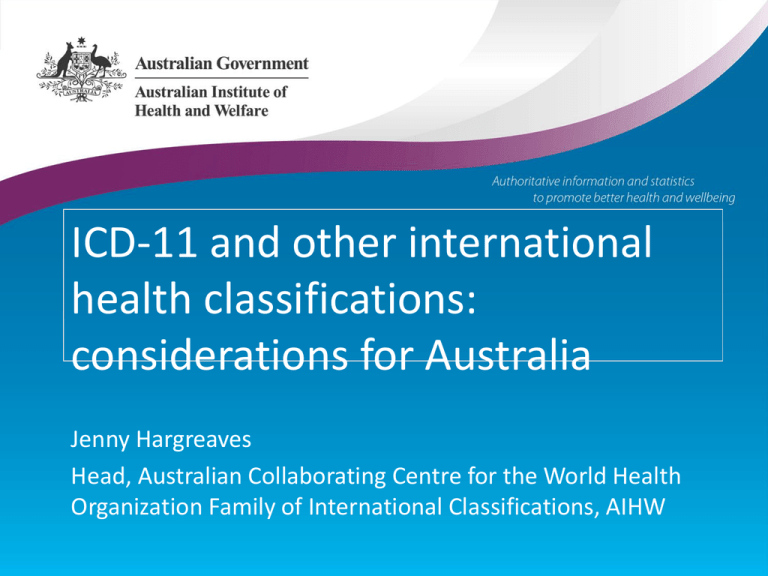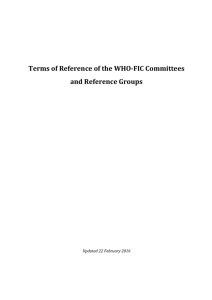
ICD-11 and other international
health classifications:
considerations for Australia
Jenny Hargreaves
Head, Australian Collaborating Centre for the World Health
Organization Family of International Classifications, AIHW
This presentation covers
• Overview of the World Health Organization’s Family
of International Classifications
• Brief information on the Australian Collaborating
Centre for the WHO’s Family of International
Classifications
• Information about the development of ICD-11 and
WHO’s plans for field trials
• Brief information about other WHO classification
development
• Thoughts about Australian involvement
2
The WHO Family of International
Classifications
• Reference classifications: main classifications on
basic parameters of health
•
•
•
International Classification of Diseases (ICD)
International Classification of Functioning, Disability and
Health (ICF)
International Classification of Health Interventions (ICHI)
(under development)
• Derived and related classifications (eg ICD-O, ICPC-2,
country versions such as ICD-10-AM)
3
WHO Classification development work
•
•
•
•
ICD revision – preparing ICD-11
Updates to ICD-10
Updates to ICF
Development of ICHI
• By WHO; with assistance of the WHO-FIC
collaborating centres
4
WHO-FIC Collaborating Centres
• A dozen or so Centres around the world, working as a
collaborative network
• Work with WHO in the development, dissemination,
maintenance and use of the WHO-FIC for statistics,
evidence
• Participate in updating processes for ICD and ICF
• Work with relevant WHO regional offices (Western
Pacific)
5
What is the Australian Collaborating
Centre?
• Network of individuals and organisations
throughout Australia who have expertise or interest
in health classifications
• Coordination and information sharing through AIHW
• Liaison with WHO, contributions to WHO work such
as classification development
• Funding support from Department of Health and
Ageing
6
Australian Collaborating Centre members
AIHW
Australian Bureau of Statistics
National Casemix and Classification Centre (UoW)
National Centre for Classification in Health (USyd)
National Centre for Health Information Research and Training (QUT)
Australian ICF Disability and Rehabilitation Research Program (USyd)
Family Medicine Research Centre (USyd)
Department of Health and Ageing
Some state and territory health departments
Individual experts
New members welcome!
7
Acknowledgment for content in the following
slides:
Bedirhan Ustun, Head of Classifications, Terminologies
and Standards, WHO
8
WHO’s ICD-11 Revision
Goals
Evolve a multi-purpose and coherent classification
1.
–
–
Mortality, morbidity, primary care, clinical care,
research, public health…
Consistency & interoperability across different uses
2.
Serve as an international and multilingual reference standard for
scientific comparability and communication purposes
3.
Ensure that ICD-11 will function in an electronic
environment
health records
9
ICD-11 processes
• Overseen by the ICD Revision Steering Group
• Development of chapter content by specialist Topic
Advisory Groups
• WHO coordination and checking
• Review by experts worldwide
• Review by ‘Cross-cutting’ Topic Advisory Groups –
mortality, morbidity, functioning and safety and
quality
• Field trials
ICD-11 Timeline
• 2011 : Alpha version ( ICD 11 alpha draft)
– Alpha browser available on-line since May 2011
– Commenting facility since about November 2011
• 2013 : Beta version Field Trials Version
– +2 YR : Field trials
• 2015 : Final version for WHA Approval
– 2015+ implementation
THE CONTENT MODEL
Any Category in ICD is represented by:
1.
2.
ICD Concept Title
7.
1.1. Fully Specified Name
7.1.
7.2.
7.3.
7.4.
7.5.
Classification Properties
2.1. Parents
2.2 Type
2.3. Use and Linearization(s)
3.
Textual Definition(s)
4.
Terms
4.1. Base Index Terms
4.2. Inclusion Terms
4.3. Exclusions
5.
Body Structure Description
5.1. Body System(s)
5.2. Body Part(s) [Anatomical Site(s)]
5.3. Morphological Properties
6.
Manifestation Properties
6.1. Signs & Symptoms
6.2. Investigation findings
8.
Causal Properties
Etiology Type
Causal Properties - Agents
Causal Properties - Causal Mechanisms
Genomic Linkages
Risk Factors
Temporal Properties
8.1. Age of Occurrence & Occurrence Frequency
8.2. Development Course/Stage
9.
Severity of Subtypes Properties
10. Functioning Properties
10.1. Impact on Activities and Participation
10.2. Contextual factors
10.3. Body functions
11. Specific Condition Properties
11.1 Biological Sex
11.2. Life-Cycle Properties
12. Treatment Properties
13. Diagnostic Criteria
Current Status as of 30 April 2013
• Some Chapters need further work
–
–
–
–
Neoplasms
Signs & Symptoms
External Causes
Z codes
• Other chapters’ structure reported to be complete
– Mental Health, Sexual Health,
– Sexual health is a new chapter
• Definitions
– Top level > 50 %
– Overall > 35 %
13
Morbidity111
Mort/PCHigh 11
Morbidity112
Mort/PCHigh 12
PC – Low 1
Morbidity121
Morbidity131
Mort/PCHigh 13
Morbidity132
Morbidity133
PC – Low 2
Mort/PCHigh 21
Morbidity211
Morbidity221
Mort/PCHigh 22
Morbidity222
Mort/PCHigh 31
PC – Low 3
Morbidity311
Morbidity312
Mort/PCHigh 32
Morbidity321
Mort/PCHigh 33
PRIMARY CARE Low Resource
Morbidity341
Mort/PCHigh 34
(Verbal Autopsy ?)
Mort/PCHigh 35
Morbidity342
Morbidity351
Extensions
PRIMARY CARE High Resource
MORBIDITY
MORTALITY
International
14National Linearizations
Specialty - Research
ICD ~ SNOMED-CT Common Ontology
Core subset of ICD Foundation Component
& SNOMED CT
• Shared concepts:
– fully specified names; definitions; synonyms
• Same parent-child relationships
• Actual scope yet to be specified
• Likely to include at least the 15,000 concepts in ICD
• First ‘experiment’ is to develop a small slice of common
ontology for cardiovascular disease
Information Notes
1.
2.
3.
4.
5.
ICD Revision Communication
ICD Revision Timelines
TAG Allocation
Content Model
Foundation Component and
Linearizations
6. Legacy Linearizations
7. Code Structure
8. Multidimensional Coding
9. Index
10. Diagnosis Type
11.Main Condition
12.Review Process
13.Mirror Coding
14.Modifiers and Qualifiers
15.Field Trials
16.Stability Analysis
17.Multilingual ICD Platform
18.Dagger and Asterisk resolution
19.Multisystem Chapter
16
Information Notes under development
20. Cross-cutting TAG Roles
a.
b.
c.
d.
21.
22.
23.
24.
25.
26.
27.
Mortality
Morbidity
Functioning
Quality & Safety
Post-Coordination Principles and Rules
Residual Categories
Common Ontology with SCT
Coding Rules
National Linearizations in ICD-11
ICD-11 Definitions
Synchronization of Update and Revision Process
17
Stability Analysis
• Mortality
• Morbidity
–
–
–
–
–
ICD-10-WHO with ICD-11-WHO
ICD-10&11-WHO with ICD-10-GM
ICD-10&11-WHO with ICD-10-CA
ICD-10&11-WHO with ICD-10-AM
ICD-10&11-WHO with ICD-10-CM
– Potentially a very useful resource
18
Review Process
• The review process will help WHO assure the
quality of the Beta Content
• Review focus:
– Scientific accuracy
– Completeness of each unit
– Internal consistency
– Utility / Relevance of each unit
Review Process
• The coverage:
– the content
• Definitions
• Content model parameters
– The structure - of the linearization (s)
• Mortality
• Morbidity
• Primary Care
• The reviewers:
– scientific peers
– Contributors being sought
ICD-11 Field Trials: overall objectives
Systematically test the ICD-11 before its use to
– increase consistency,
– identify improvement paths, and
– reduce errors
ICD-11 Field Trials: Basic aims
– To test the “fitness of ICD-11 for multiple purposes”
• Mortality coding
• Morbidity coding including DRG effects
• Other use cases
– In different health settings
• Primary care (high resource and low resource settings)
• General health care, and specialised care settings
• Research settings – epidemiology and population health, and clinical
research
– To ensure the comparability between ICD-10 and ICD-11
ICD-11 Field Trials: Key Assessments
– Applicability – feasibility easy to use
– Reliability - consistency gives same results
in the hands of all
– Utility - added value renders useful
information
Management of Field trials
• Field trials Structure
– WHO (central organization)
– Field Trial Centres (WHO FIC CC, others?)
– Field Trial Sites
• Roles & Responsibilities
– Coder/rater
– Site coordinator & assistant
– Centre coordinator & assistant
Field Trial Studies
1. Core Studies (mandatory)
– Study One:
• Basic Questions
– Study Two:
• Reliability & Feasibility
– Study Three:
• Bridge Coding
2. Additional Studies – eg testing index
Possible Basic Question topics
1. Need for ICD-11 – clinical care, statistics,
reimbursement, research
2. Uses for ICD-11
3. Characteristics of ICD-11
4. Diseases conceptions & delineation
5. Terminology principles
6. Coding
7. Coverage issues
8. ICD-11 and other WHO FIC
9. Other
Basic Question Components
Individual Response
Approach
• Consensus Conference
Approach
Study on reliability & feasibility
• The Case information
• Case Summaries (CS)
• Live Cases (LC)
• Other (e.g. Video Cases)
• Coded using ICD-11 Chapters by at least two
different people
• Agreement rates measured
• Processes of joint discussion of differences
Bridge Coding study
• The Case information
• live
• medical record
• Coded using
• ICD10
• ICD11
• Agreement rates
measured
Field trial data management & issues
• Data management
– Infrastructure
• (web-base software (multilingual) & Paper and pencil
– Workflow
• Entry, check/validation/submission
Ethics review (e.g. WHO ERC, national ERC)
– As required
Field trials timing
• Currently in consolidation phase at WHO
• A draft classification to be delivered to
mortality and morbidity Topic Advisory Groups
in late June
• Field trials starting end of June, for two years
• Pilot testing and more planning over coming
months
ICD-11 Field trials in Australia?
• Monitor and contribute to current planning?
• Participate in field trials
–
–
–
–
Acute care
Other – primary care? Population health? Research?
Early in the process? Late? Both?
Extend to test effects on DRGs? On coder resource
requirements? On information requirements?
• To help shape final ICD-11 product to suit Australia’s needs,
particularly if we want to consider not having a national
modification, or having a minimal national modification
Infectious diseases: change for
field testing?
• An expansion of content on organisms, as first axis
• Should the chapter continue with focus on epidemic
and generalised infections? For public health purposes;
not appropriate in other chapters?
• Or focus on manifestation, with aetiology postcoordinated?
• Or will the new structure work?
(Thanks to Olafr Steinham from the Nordic WHO-FIC Collaborating Centre)
X chapter – extension codes
• To support multi-dimensional coding or postcoordinated coding
• Paired with stem codes from elsewhere in the
classification
• 3 types:
– Type 1 – additional detail eg severity, laterality
– Type 2 - administrative eg main condition, present on
admission
– Type 3 – stem code as reference, eg ‘rule out’, ‘family history
of’
35
• Balance of pre/post coordination still being worked on by WHO
X chapter, continued
• Extension codes used with ‘cluster codes’ to group codes
representing single concepts, eg
– CodeA 1
– CodeB 1
– CodeC 1
•
•
•
•
Or chain coding: CodeA/CodeB/CodeC 1
These have equivalent meaning
Impacts on information systems
For field trials, will the required information be available in
linkable form? How would it relate to ACS for Additional
diagnoses?
National modifications
• WHO Information Note not yet published –
approach not yet known
• To be influenced by X chapter arrangements,
and stability analyses?
• X chapter could accommodate detail currently
in national modifications
• National modifications could be (largely)
choices about use of X chapter features?
National modifications, ctd
• Links to national information systems/regulations/funding
arrangements
• Links to update process for ICD-11
– Frequency and timing? Turnaround time?
– processes for proposing, considering and approving
updates?
• Content and construct issues
• Specific country needs eg external causes
• A balance between international comparability and specific
national needs
(Thanks to ACC colleagues for discussions on these topics)
ICD-11 Australian implementation?
•
•
•
•
Mortality
Morbidity – acute care, other
Post 2015?
Consider after testing of final ICD-11?
International Classification of
Functioning, Disability and Health
• ICF used in ABS Survey of Disability, Ageing and
Carers, and other national health information work
– eg AIHW’s current work to develop a ‘standardised disability flag’
module for Community Services Ministers to improve information on
people with disability accessing mainstream services
• Combining ICF for children and youth into ICF
– Combining foundation layer
• Development of information model
• ICF practical manual
• Annual updates for ICF
Annual updates for ICF
• Australian ICF updates workshop
• Repeating last’s year’s successful workshop
• Collaborative Australian input into WHO
processes
• Only France also doing this
• A model for how Australia could contribute to
ICD updates?
International Classification of
Health Interventions
• Work to date, including Alpha version ‘spearheaded’
by Richard Madden, University of Sydney
• Medical, surgical, public health, nursing and
functioning interventions
• Business plan – uses and users
• Detailed project plan
• Management committee
• For WHO Governing Body endorsement, ultimately
International Classification of
Health Interventions
• Considerations for Australia
• A longer term development than ICD-11
• Likely to be developed to link with emerging ehealth environment
• A replacement for ACHI? More future proof?
• Australian involvement?
Family Development Committee
• More work looking into the future
• A Committee of the WHO-FIC Network of
Collaborating Centres
• Advises WHO on additions and other changes
to the Family
Family Development Committee
• Applications of the WHO-FIC – use of ICD, ICF and
ICHI together, and for casemix in particular
• Stocktake of current and future use of WHO-FIC in
casemix
• Principles on which a casemix system should be
developed, particularly from a classification
perspective
• Focal point for ICHI – advice on project management,
preparation of a statement of benefits, advice on
links to other WHO-FIC members
Family Development Committee
• Health services classification – role in the Family?
Costs and benefits? Priority? Link to OECD system of
accounts? Australian hospital peer groups?
Australian health expenditure classifications?
• WHO-FIC support for the WHO’s Universal Health
Coverage initiative - primary care versions of the
classifications, reasons for encounter in general
practice, presenting problems in emergency
departments? Other patient perspectives?
Population health measures and risk factors?
Alignment with other primary care classifications?
Family Development Committee
•
•
•
•
•
•
•
•
•
•
Integration of the Family: a Family-wide development
What does this mean? At what level? For what purpose?
Alignment or combining of content models
Alignment or combining of foundation layers
Rules for derived and related classifications
Processes for adding and deleting classifications
Alignment of pre-and post-coordination approaches
Identification and filling of gaps
Incorporation of specialist classifications into the reference set
Approaches to mapping between WHO-FIC members and with
other classifications and terminologies
Considerations for Australia, in summary
•
•
•
•
•
•
•
Ensuring that the Family of International Classifications suits
Australia’s purposes into the future?
• For both internal Australian purposes - and for international
comparability and potential use of international products?
Involvement in ICD-11 content preparation
Involvement in ICD-11 field trials
Involvement in ICD-10 updates (to morph into ICD-11 updates)
Involvement in establishment phase for ICHI
Involvement in update process for ICF
Watching brief on longer term WHO work










